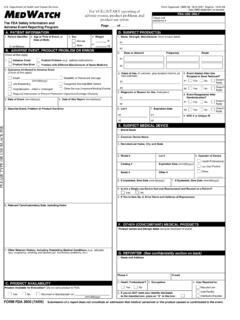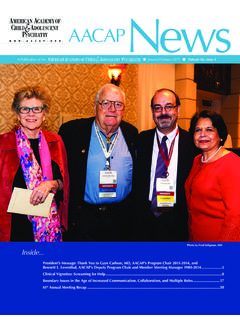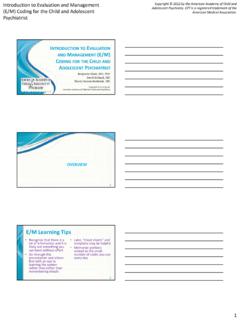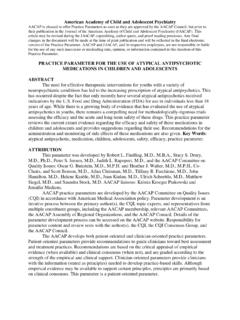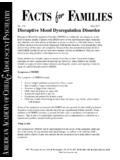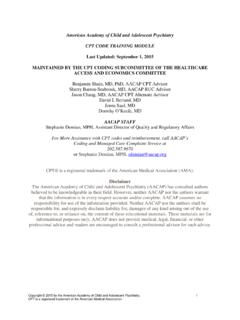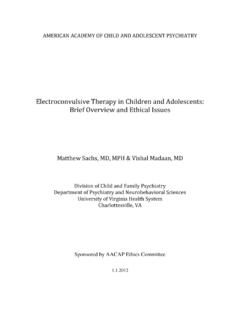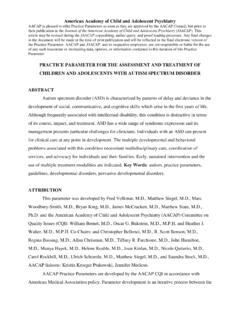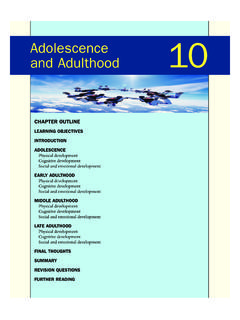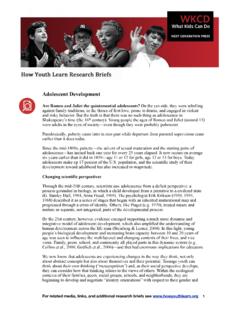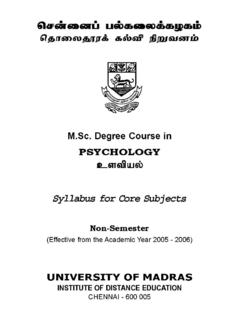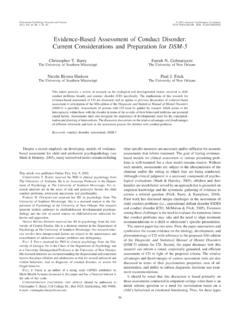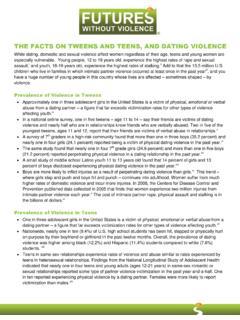Transcription of Revised July 2013
1 ADHD. parents medication guide Revised July 2013. Attention-Deficit/Hyperactivity Disorder Prepared by: American Academy of Child & Adolescent Psychiatry and American Psychiatric Association Supported by the Elaine Schlosser Lewis Fund Physician: _____. Address: _____. _____. _____. Phone: _____. Email: _____. ADHD parents medication guide July 2013 2. Introduction Attention-De cit/Hyperactivity Disorder (ADHD) is a neurodevelopmental disorder characterized by difficulty paying attention, excessive activity, and impulsivity (acting before you think). ADHD is usually identified when children are in grade school but can be diagnosed at any time from preschool to adulthood. Recent studies indicate that almost 10 percent of children between the ages of 4 to 17 are reported by their parents as being diagnosed with ADHD.
2 So in a classroom of 30 children, two to three children may have ,2,3,4,5. Short attention spans and high levels of activity are a normal part of childhood. For children with ADHD, these behaviors are excessive, inappropriate for their age, and interfere with daily functioning at home, school, and with peers. Some children with ADHD only have problems with attention; other children only have issues with hyperactivity and impulsivity; most children with ADHD have problems with all three. As they grow into adolescence and young adulthood, children with ADHD may become less hyperactive yet continue to have signi cant problems with distraction, disorganization, and poor impulse control. ADHD can interfere with a child's ability to perform in school, do homework, follow rules, and develop and maintain peer relationships.
3 When children become adolescents, ADHD can increase their risk of dropping out of school or having disciplinary problems. Adolescents with ADHD may also experience an increased risk of driving violations and accidents, are more likely to smoke cigarettes and abuse drugs, have problems with employment, and experience other mental health problems in addition to ADHD. Early identification of ADHD is advisable children are most often identified in elementary school. Effective behavioral and medication treatments are available to help manage the symptoms of ADHD. These treatments can improve functioning at home, school, and in social situations. Before treatment begins, each child should have a comprehensive assessment to make the diagnosis and plan for treatment.
4 This medication guide is intended to help youngsters with ADHD and their families to better understand the treatments for ADHD. ADHD parents medication guide July 2013 3. Causes, Symptoms & Choosing Treatment What is ADHD? ADHD is a condition with symptoms that include excessive Potential Consequences when restlessness, poor attention, and impulsive acts. There are three ADHD is Left Untreated major presentations of ADHD: predominantly inattentive, in which Increased risk for school failure and dropout in both high school and children and adolescents have problems concentrating and college focusing; predominantly hyperactive-impulsive, in which children Behavior and discipline problems and adolescents experience impulsivity and excess activity; and Social difficulties and family strife combined type, in which children and adolescents experience Accidental injury symptoms of inattention, hyperactivity, and impulsivity.
5 Alcohol and drug abuse Depression, anxiety and other What causes ADHD? mental health disorders Research has not found a single cause for ADHD, but has proven Employment problems that it runs in families and is likely due to many genes and their Driving accidents interaction with the ,7,8,9 The rate at which the Unplanned pregnancy and sexually disorder is inherited, about 75 percent, is similar to the rate at transmitted diseases which children's height is inherited. Scientists are currently Delinquency, criminality, and arrest looking for the genes and environmental factors that may lead to the development of ADHD. Substances in the environment and other factors have been identified that may contribute to the development of ADHD.
6 These include low birth weight; exposure to cigarette smoke, alcohol, herbicides, or pesticides as a fetus in the womb; and exposure to toxic substances in the environment such as lead from old paint after ,8,10,11,12 Environmental factors require further research to establish their role in the development of ADHD. How can I find out if my child has ADHD? There is no laboratory test that can detect ADHD with certainty. Clinicians such as pediatricians, child and adolescent psychiatrists, and other allied professionals will decide on the diagnosis based on interviews with you and your child, and feedback from your child's school about his or her ability to pay attention, level of activity, and impulsivity.
7 This is done by evaluating your child's overall development, family and peer relationships, and medical history for information that might indicate other problems besides ADHD that could also explain the symptoms. Clinicians will also work to detect a pattern of social interactions in several different settings, and finally, to determine degree of frustration tolerance, and related factors. For more information about the criteria for the current diagnosis of ADHD, click here. ADHD parents medication guide July 2013 4. ADHD Symptom Manifestations in Adolescents and Adults ADHD inattention symptoms can be manifest many ways in young adults. These include:13. Poor time management skills Avoiding tasks demanding attention Putting off tasks and activities (procrastination).
8 Excessive multitasking leading to tasks being incomplete Problems with starting or completing tasks, or failure to switch tasks when indicated Needing to adapt a lifestyle to fit the limitations and assets of a short attention span Needing support staff or external structure for functioning ADHD hyperactivity symptoms can be manifest many ways in young adults. These include: Experiencing a constant inner sense of restlessness Selecting a job or jobs that require working long hours, high levels of activity, or multiple tasks Avoiding jobs that require sedentary or low level activity Family tension resulting from constant activity ADHD symptoms of impulsiveness can be manifest many ways in young adults.
9 These include: Becoming easily frustrated Changing one's personal relationships or jobs frequently Difficulties with automobile driving leading to multiple traffic infractions or accidents Easily losing one's temper Making hasty decisions Having low tolerance for stress Interrupting conversations, speaking out without thinking of the consequences Research is ongoing to better understand the ways in which ADHD affects brain function and how to best treat the condition. Other research is looking at the long-term outcomes for people with ADHD, particularly regarding grade completion, social relationships, and success in the workplace. The more we learn about ADHD and its treatment and the more information we share with youth, the better the care and outcome of treatment that can be expected.
10 When can ADHD be diagnosed? Most cases of ADHD are diagnosed when the child is 7 or 8 years old, but ADHD symptoms and impairment can be apparent as early as age 3-5, when the child is in preschool or kindergarten. Girls are often identified later than boys. Bright children may not be diagnosed until later as they may compensate for their difficulties until school work gets more challenging. ADHD symptoms must be present for at least six months before a child can be diagnosed with ADHD, and symptoms should be present before age 12. For more information on ADHD changes, click here. Why are more boys than girls diagnosed with ADHD? Boys diagnosed with ADHD outnumber girls a little over ,4 Some doctors think that almost as many girls have ADHD as boys,4 but they are not diagnosed as often, possibly because they are less ADHD parents medication guide July 2013 5.
